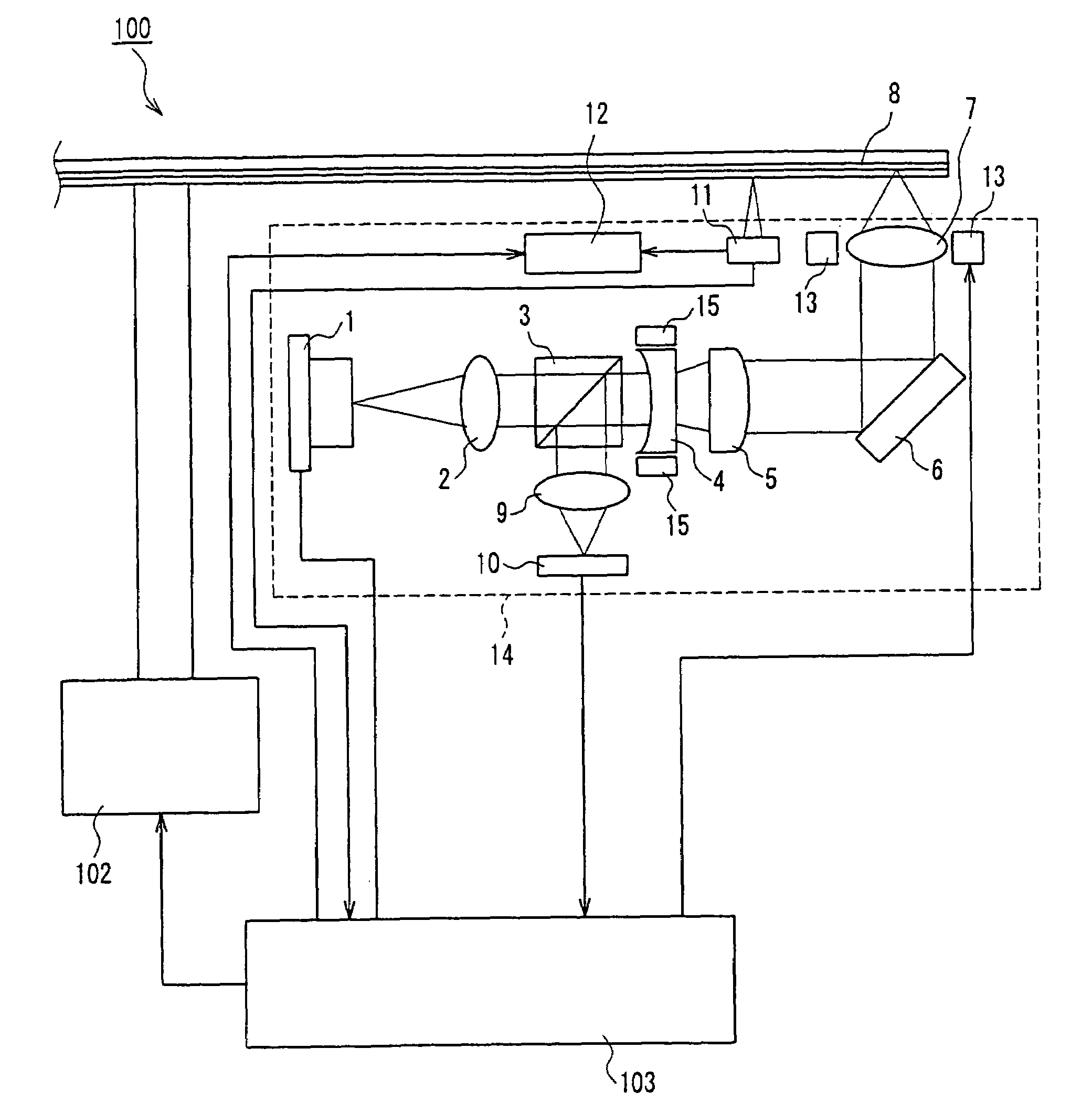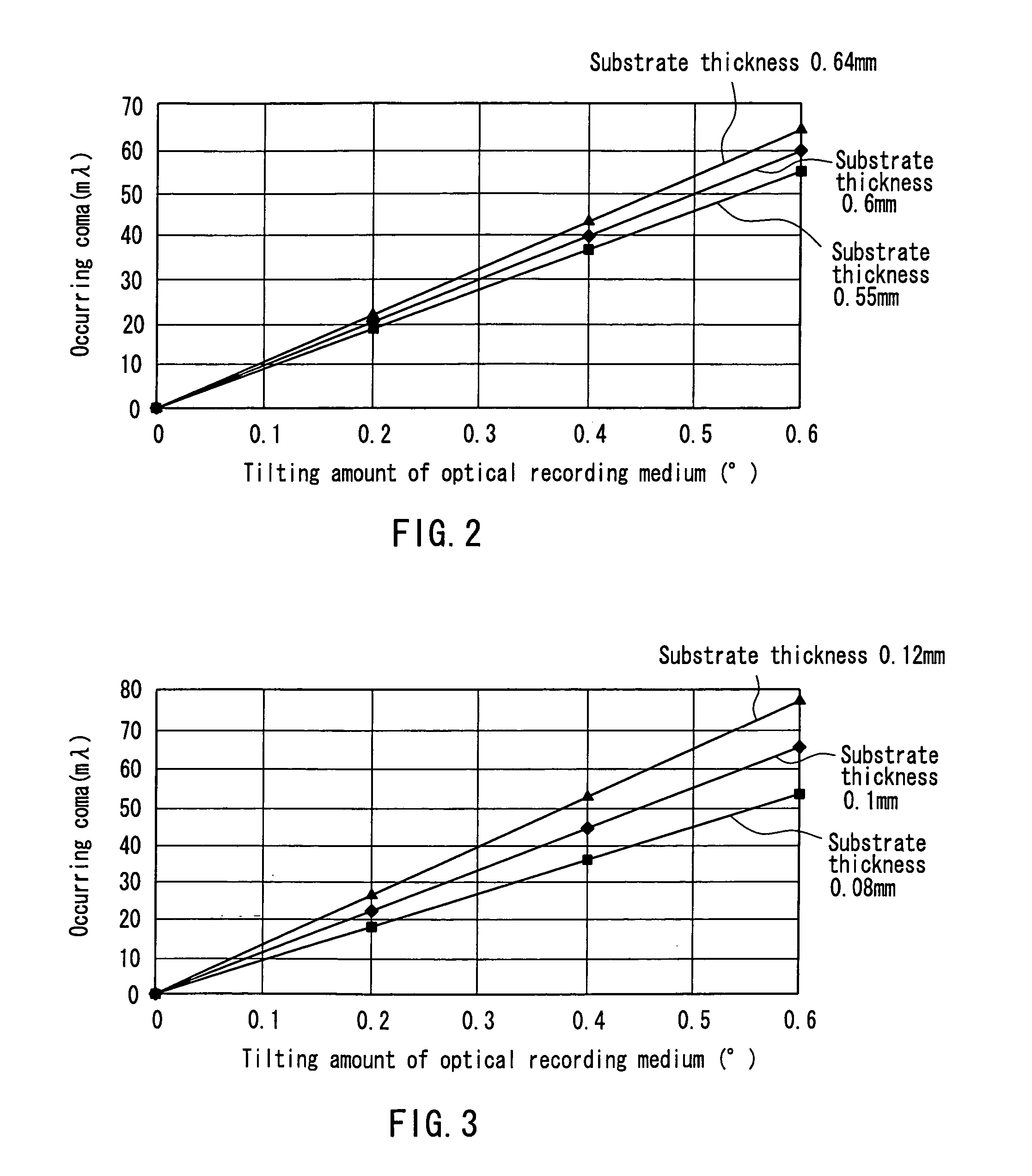Optical head and optical recording/reproducing device using it and aberration correction method
a technology of optical recording/recording device and optical head, which is applied in the direction of digital signal error detection/correction, instruments, recording signal processing, etc., can solve the problems that the optical head with the foregoing configuration cannot be used for multi-layer optical recording medium, and the occurrence of aberration due to tilt of optical recording medium becomes a problem, etc., to achieve stable recording
- Summary
- Abstract
- Description
- Claims
- Application Information
AI Technical Summary
Benefits of technology
Problems solved by technology
Method used
Image
Examples
first embodiment
[0038]FIG. 1 is a schematic view illustrating an optical head according to a first embodiment of the present invention.
[0039]In FIG. 1, 1 denotes a light source, and a GaN-type semiconductor laser element (wavelength: 405 nm), for instance, is used as the light source 1. This light source 1 emits a coherent light for recording and reproducing to a recording layer of the optical recording medium 8. 2 denotes a collimator lens, and this collimator lens 2 is a lens for converting divergent light emitted from the light source 1 into parallel light. 3 denotes a beam splitter, and this beam splitter 3 is an optical element that transmits approximately 50% of light incident thereon and reflects approximately 50% of the same. 4 denotes a concave lens as a negative lens group, and this concave lens 4 is a lens intended to convert light that first has been converted into parallel light by the collimator lens 2 into divergent light again. 5 denotes a convex lens as a positive lens group, and t...
second embodiment
[0058]FIG. 5 is a schematic view illustrating an optical head according to a second embodiment of the present invention.
[0059]As shown in FIGS. 1 and 5, an optical head 16 (FIG. 5) of the present embodiment is different from the optical head 14 (FIG. 1) of the first embodiment described above only in that the optical head 16 includes a substrate thickness detecting means for detecting information concerning a substrate thickness of an optical recording medium 8, and the configuration of the optical head 16 except for the foregoing aspect is identical to that of the first embodiment. Therefore, herein the details of the present embodiment that are not specifically described are considered to be identical to those of the first embodiment described above, and the constituent members denoted with the same reference numerals as those in the first embodiment are considered to have the same functions as those of the first embodiment unless they are described specifically.
[0060]In FIG. 5, 5...
third embodiment
[0092]FIG. 10 is a view schematically illustrating an optical recording / reproducing device according to a third embodiment of the present invention.
[0093]The optical recording / reproducing device of the present embodiment is a device for recording and reproducing signals to and from a single-layer or multi-layer optical recording medium. As shown in FIG. 10, an optical recording / reproducing device 100 according to the present embodiment includes the optical head 14 of the first embodiment described above, a motor 102 for rotating the optical recording medium 8, and a processing circuit 103. Though the optical head of the first embodiment described above is used here, the optical head of the second embodiment described above may be used instead. Since the optical head is the same as that described in conjunction with the first embodiment, duplicate descriptions thereof are omitted.
[0094]Next, an operation of the optical recording / reproducing device 100 having the foregoing configurati...
PUM
| Property | Measurement | Unit |
|---|---|---|
| thickness | aaaaa | aaaaa |
| thickness | aaaaa | aaaaa |
| thickness | aaaaa | aaaaa |
Abstract
Description
Claims
Application Information
 Login to View More
Login to View More - R&D
- Intellectual Property
- Life Sciences
- Materials
- Tech Scout
- Unparalleled Data Quality
- Higher Quality Content
- 60% Fewer Hallucinations
Browse by: Latest US Patents, China's latest patents, Technical Efficacy Thesaurus, Application Domain, Technology Topic, Popular Technical Reports.
© 2025 PatSnap. All rights reserved.Legal|Privacy policy|Modern Slavery Act Transparency Statement|Sitemap|About US| Contact US: help@patsnap.com



